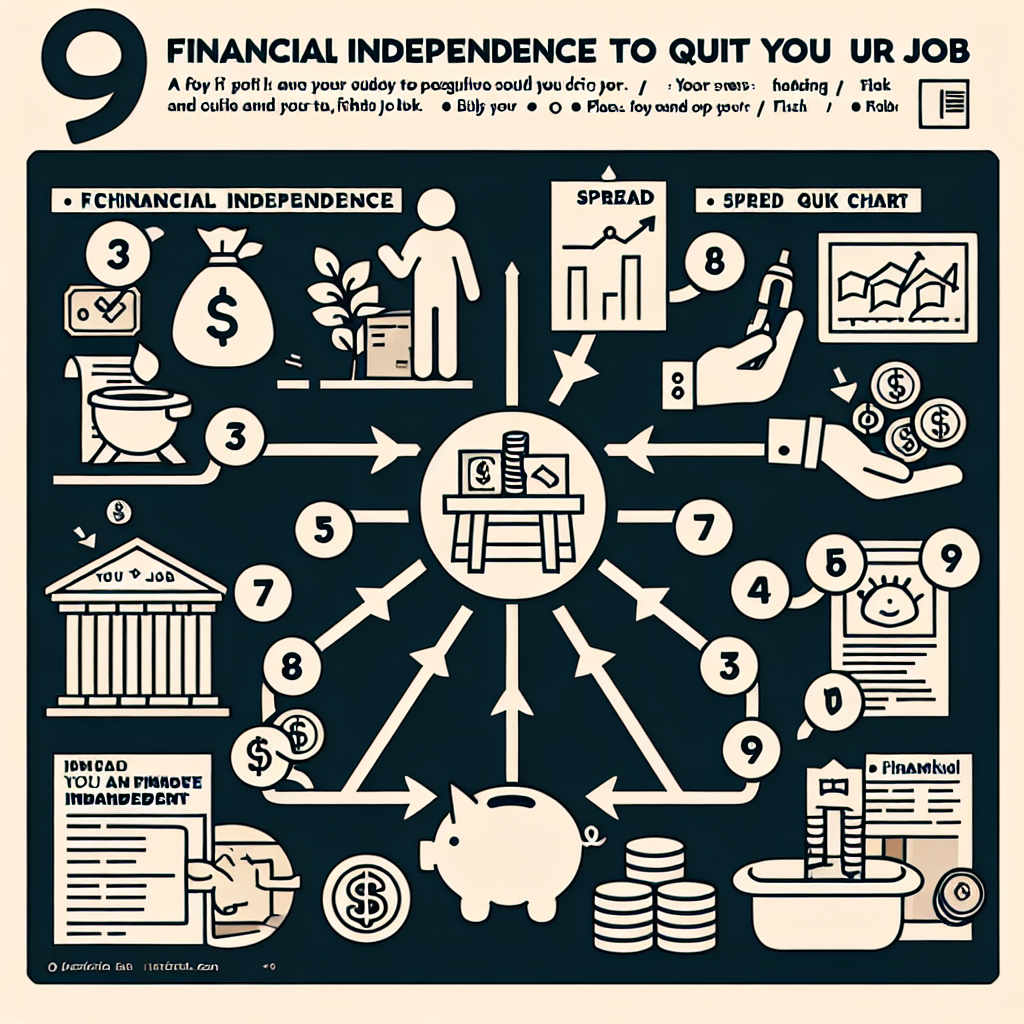-
Table of Contents
- 9 Strategies to Achieve Financial Independence and Quit Your Job
- 1. Set Clear Financial Goals
- 2. Create a Budget and Stick to It
- 3. Build an Emergency Fund
- 4. Pay Off High-Interest Debt
- 5. Invest Wisely
- 6. Increase Your Income
- 7. Live Below Your Means
- 8. Plan for Retirement
- 9. Continuously Educate Yourself
- Case Studies and Examples
- Case Study 1: The Frugal Millionaire
- Case Study 2: The Side Hustler
- Case Study 3: The Investor
- Conclusion
9 Strategies to Achieve Financial Independence and Quit Your Job

Achieving financial independence and quitting your job is a dream for many. The idea of having the freedom to pursue your passions, travel the world, or simply enjoy more time with family is incredibly appealing. However, reaching this goal requires careful planning, disciplined execution, and a solid understanding of financial principles. In this article, we will explore nine strategies that can help you achieve financial independence and ultimately quit your job.
1. Set Clear Financial Goals
The first step towards financial independence is setting clear and achievable financial goals. Without a roadmap, it’s easy to get lost or distracted. Your goals should be specific, measurable, attainable, relevant, and time-bound (SMART).
- Specific: Define exactly what you want to achieve. For example, “I want to save $1 million by the age of 50.”
- Measurable: Ensure you can track your progress. For instance, “I will save $20,000 per year.”
- Attainable: Set realistic goals based on your current financial situation.
- Relevant: Make sure your goals align with your long-term objectives.
- Time-bound: Set a deadline for achieving your goals.
By setting clear financial goals, you create a roadmap that guides your financial decisions and keeps you focused on your path to independence.
2. Create a Budget and Stick to It
A budget is a powerful tool that helps you manage your money effectively. It allows you to track your income and expenses, identify areas where you can cut costs, and allocate funds towards your financial goals.
To create a budget:
- List all sources of income.
- Track all your expenses, including fixed costs (rent, utilities) and variable costs (groceries, entertainment).
- Identify areas where you can reduce spending.
- Allocate a portion of your income towards savings and investments.
Sticking to your budget requires discipline and regular monitoring. Use budgeting apps or spreadsheets to help you stay on track and make adjustments as needed.
3. Build an Emergency Fund
An emergency fund is a crucial component of financial independence. It provides a safety net in case of unexpected expenses, such as medical emergencies, car repairs, or job loss. Without an emergency fund, you may be forced to dip into your savings or go into debt, derailing your financial goals.
Experts recommend saving three to six months’ worth of living expenses in an easily accessible account, such as a high-yield savings account. Start by setting aside a small amount each month and gradually build your emergency fund over time.
4. Pay Off High-Interest Debt
High-interest debt, such as credit card debt, can be a significant obstacle to financial independence. The interest charges can quickly accumulate, making it difficult to save and invest for the future.
To pay off high-interest debt:
- List all your debts, including the interest rates and minimum payments.
- Focus on paying off the debt with the highest interest rate first while making minimum payments on the others (the avalanche method).
- Alternatively, you can use the snowball method, where you pay off the smallest debt first to build momentum.
- Consider consolidating your debt with a lower-interest loan or balance transfer credit card.
By eliminating high-interest debt, you free up more money to save and invest, accelerating your journey to financial independence.
5. Invest Wisely
Investing is a key strategy for building wealth and achieving financial independence. By investing your money, you can take advantage of compound interest and grow your wealth over time.
Here are some investment options to consider:
- Stock Market: Investing in stocks can provide high returns, but it also comes with higher risk. Diversify your portfolio to mitigate risk.
- Bonds: Bonds are generally safer than stocks and provide steady income through interest payments.
- Real Estate: Investing in real estate can provide rental income and potential appreciation in property value.
- Mutual Funds and ETFs: These investment vehicles pool money from multiple investors to invest in a diversified portfolio of stocks, bonds, or other assets.
- Retirement Accounts: Contribute to retirement accounts like 401(k)s or IRAs to take advantage of tax benefits and employer matching contributions.
It’s essential to educate yourself about different investment options and develop a diversified portfolio that aligns with your risk tolerance and financial goals. Consider consulting a financial advisor for personalized advice.
6. Increase Your Income
While cutting expenses and saving money are important, increasing your income can significantly accelerate your path to financial independence. There are several ways to boost your income:
- Ask for a Raise: If you have been performing well at your job, consider negotiating a raise with your employer.
- Switch Jobs: Sometimes, changing jobs can lead to a higher salary and better benefits.
- Start a Side Hustle: Use your skills and talents to start a side business or freelance work. Popular side hustles include tutoring, graphic design, writing, and ride-sharing.
- Invest in Education: Acquiring new skills or certifications can make you more valuable in the job market and lead to higher-paying opportunities.
By increasing your income, you can save and invest more, bringing you closer to financial independence.
7. Live Below Your Means
Living below your means is a fundamental principle of financial independence. It involves spending less than you earn and avoiding lifestyle inflation, where your expenses increase as your income rises.
To live below your means:
- Adopt a frugal mindset and prioritize needs over wants.
- Avoid unnecessary debt and pay off credit card balances in full each month.
- Look for ways to save on everyday expenses, such as cooking at home, using public transportation, and shopping for deals.
- Automate your savings and investments to ensure you consistently set aside money for your financial goals.
By living below your means, you can save more money and invest it for the future, accelerating your journey to financial independence.
8. Plan for Retirement
Planning for retirement is a critical aspect of achieving financial independence. The earlier you start saving for retirement, the more time your money has to grow through compound interest.
To plan for retirement:
- Determine how much money you will need to retire comfortably. Consider factors such as living expenses, healthcare costs, and desired lifestyle.
- Contribute to retirement accounts like 401(k)s, IRAs, or Roth IRAs. Take advantage of employer matching contributions if available.
- Diversify your retirement investments to balance risk and return.
- Regularly review and adjust your retirement plan to ensure you stay on track to meet your goals.
By planning for retirement, you can ensure you have enough money to support yourself in your later years and achieve financial independence.
9. Continuously Educate Yourself
Financial independence requires ongoing education and self-improvement. The financial landscape is constantly changing, and staying informed about new opportunities, strategies, and risks is essential.
To continuously educate yourself:
- Read books, articles, and blogs about personal finance and investing.
- Listen to podcasts and watch videos from financial experts.
- Attend workshops, seminars, and webinars on financial topics.
- Join online communities and forums to discuss financial strategies and share experiences with others.
By continuously educating yourself, you can make informed financial decisions and adapt to changes in the market, increasing your chances of achieving financial independence.
Case Studies and Examples
To illustrate the effectiveness of these strategies, let’s look at a few real-life examples:
Case Study 1: The Frugal Millionaire
John, a software engineer, started his career with a modest salary. He adopted a frugal lifestyle, living below his means and saving a significant portion of his income. John invested in low-cost index funds and contributed to his 401(k) with employer matching. Over 20 years, his investments grew substantially, allowing him to achieve financial independence and retire early at the age of 45.
Case Study 2: The Side Hustler
Sarah, a teacher, wanted to achieve financial independence but found it challenging with her salary alone. She started a side hustle as a freelance graphic designer, using her skills to earn extra income. Sarah used the additional income to pay off her student loans and invest in real estate. Within 10 years, she built a portfolio of rental properties that provided enough passive income to quit her job and focus on her passion for travel.
Case Study 3: The Investor
Mike, a marketing executive, focused on maximizing his income and investing wisely. He regularly asked for raises, switched jobs for better opportunities, and invested in a diversified portfolio of stocks, bonds, and real estate. Mike also educated himself about tax-efficient investing and took advantage of tax-advantaged accounts. By the age of 50, Mike had accumulated enough wealth to achieve financial independence and pursue his dream of starting a non-profit organization.
Conclusion
Achieving financial independence and quitting your job is a challenging but attainable goal. By setting clear financial goals, creating a budget, building an emergency fund, paying off high-interest debt, investing wisely, increasing your income, living below your means, planning for retirement, and continuously educating yourself, you can take control of your financial future.
Remember, the journey to financial independence requires discipline, patience, and perseverance. Stay focused on your goals, make informed decisions, and adapt to changes along the way. With dedication and the right strategies, you can achieve financial independence and enjoy the freedom to live life on your terms.








